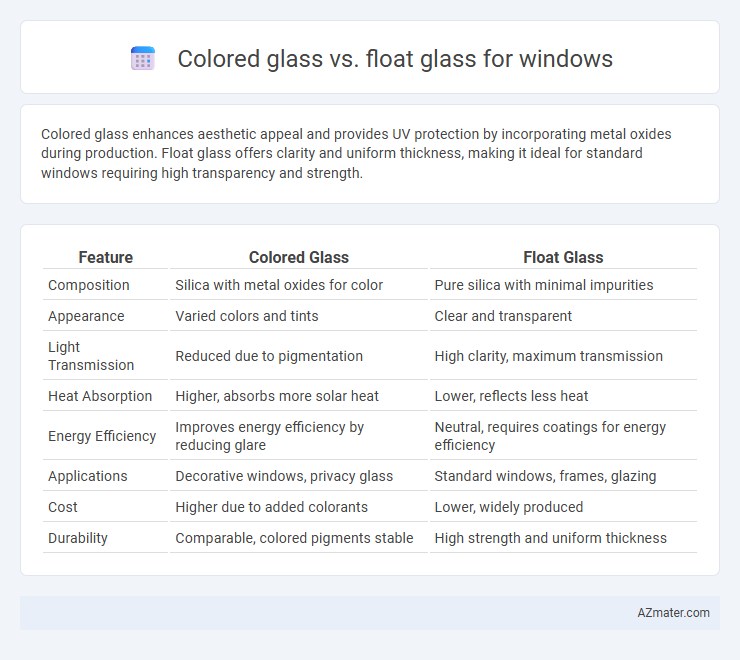Colored glass enhances aesthetic appeal and provides UV protection by incorporating metal oxides during production. Float glass offers clarity and uniform thickness, making it ideal for standard windows requiring high transparency and strength.
Table of Comparison
| Feature | Colored Glass | Float Glass |
|---|---|---|
| Composition | Silica with metal oxides for color | Pure silica with minimal impurities |
| Appearance | Varied colors and tints | Clear and transparent |
| Light Transmission | Reduced due to pigmentation | High clarity, maximum transmission |
| Heat Absorption | Higher, absorbs more solar heat | Lower, reflects less heat |
| Energy Efficiency | Improves energy efficiency by reducing glare | Neutral, requires coatings for energy efficiency |
| Applications | Decorative windows, privacy glass | Standard windows, frames, glazing |
| Cost | Higher due to added colorants | Lower, widely produced |
| Durability | Comparable, colored pigments stable | High strength and uniform thickness |
Introduction to Glass Types for Windows
Colored glass for windows enhances aesthetic appeal and offers UV protection by incorporating metallic oxides during production, creating vibrant hues that filter sunlight. Float glass, manufactured by floating molten glass on a bed of molten metal, provides a clear, uniform surface with excellent strength and transparency, making it ideal for standard window applications. Both types serve distinct purposes; colored glass excels in decorative and energy-efficient designs, while float glass is preferred for clarity and structural performance in modern architecture.
What is Colored Glass?
Colored glass is produced by adding metal oxides or other coloring agents to molten glass, resulting in vibrant hues that reduce glare and enhance aesthetic appeal in window applications. Unlike float glass, which is clear and made by floating molten glass on molten metal to achieve uniform thickness, colored glass provides both decorative and functional benefits such as UV protection and solar heat control. These properties make colored glass ideal for architectural designs requiring both visual impact and energy efficiency.
What is Float Glass?
Float glass is a type of flat glass produced by floating molten glass on a bed of molten metal, typically tin, resulting in a smooth and uniform surface free from distortions. Unlike colored glass, which incorporates metal oxides or dyes during production to achieve various hues, float glass is typically clear or slightly tinted due to iron content but can be later coated or laminated for color. Float glass serves as a fundamental substrate for windows, offering high clarity, strength, and versatility in architectural applications.
Key Differences Between Colored and Float Glass
Colored glass contains metallic oxides that provide specific hues and enhanced UV protection, while float glass is clear and made by floating molten glass on a bed of molten metal for uniform thickness. Float glass offers high transparency and is often used in standard windows, whereas colored glass reduces glare and solar heat gain, improving energy efficiency. The choice between colored and float glass impacts aesthetics, light transmission, and thermal performance in window applications.
Aesthetic Appeal: Colored vs Float Glass
Colored glass offers vibrant hues and decorative patterns that enhance architectural aesthetics by adding character and visual interest to windows, making it ideal for artistic and bespoke designs. Float glass provides a clear, smooth surface that maximizes natural light transmission and offers a minimalist, modern appearance suitable for sleek, contemporary window installations. The choice between colored glass and float glass significantly influences the ambiance and style of a space, balancing between expressive color richness and clean, unobstructed views.
Energy Efficiency Comparison
Colored glass enhances energy efficiency by selectively filtering solar radiation, reducing heat gain and lowering cooling costs in warm climates. Float glass, typically clear and untreated, allows higher solar transmission, which can increase indoor temperatures and energy demand for air conditioning. Incorporating colored glass in windows improves insulation performance by minimizing solar heat gain, contributing to significant energy savings in building climate control.
Durability and Strength Considerations
Colored glass for windows generally exhibits enhanced durability due to the inclusion of metal oxides during manufacturing, which can improve resistance to UV radiation and chemical degradation. Float glass, known for its smooth and uniform surface, offers high strength and is often tempered or laminated to meet structural requirements, making it reliable for load-bearing applications. When comparing the two, colored glass provides superior resistance to environmental factors, while float glass excels in mechanical strength and impact resistance, influencing the choice based on specific durability and strength needs.
Cost Analysis: Colored Glass vs Float Glass
Colored glass typically incurs higher costs than float glass due to the added materials and manufacturing processes required to infuse pigments and achieve consistent coloration. Float glass is more cost-effective for large-scale window installations because it is produced in bulk with standard clear specifications, reducing production and material expenses. When budgeting for construction or renovation projects, choosing float glass minimizes initial expenditure, while colored glass offers aesthetic benefits at a premium price.
Applications and Suitability in Modern Architecture
Colored glass offers enhanced aesthetic appeal and solar control, making it ideal for decorative facades, privacy screens, and energy-efficient buildings in modern architecture. Float glass provides a clear, uniform surface with high strength and cost-effectiveness, suitable for large windows, curtain walls, and structural glazing. The choice between colored and float glass depends on design goals, energy performance requirements, and visual impact desired in contemporary structures.
Choosing the Right Glass for Your Windows
Colored glass enhances aesthetic appeal and provides natural light filtering while offering moderate insulation, making it ideal for decorative window applications. Float glass, known for its smooth surface and clarity, delivers superior thermal performance and durability, suited for energy-efficient windows requiring maximum visibility. Selecting the right glass depends on balancing design preferences, insulation needs, and light transmission for optimal window functionality.

Infographic: Colored glass vs Float glass for Window
 azmater.com
azmater.com